CDS090 Episode and Attendance Details - Out-Patient and Ward Attenders CDS Types
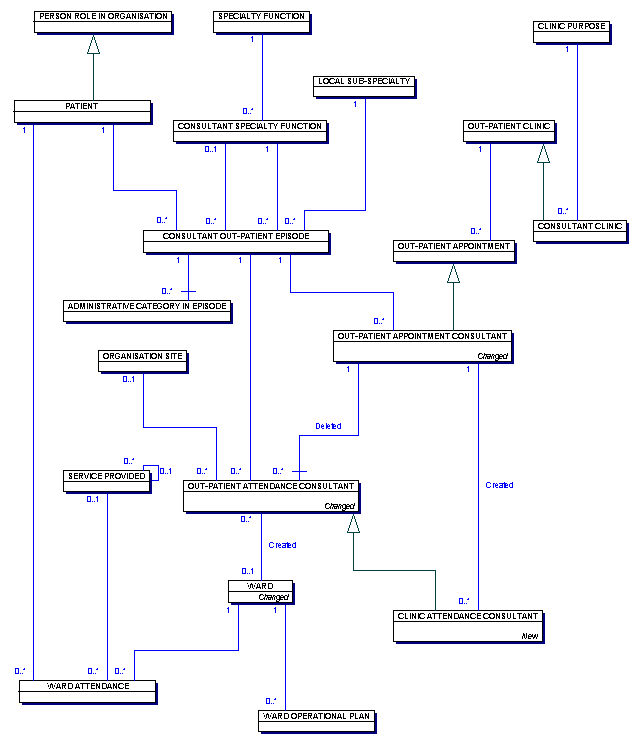
| Change Request |
| Reference: | Change Request 277 |
| Version No: | 1.3 |
| Subject: | DSCN 11/2002 |
| Type of Change: | Change to NHS Data Standards |
| Effective Date: | 1 October 2002 |
| Reason for Change: | Amendment of current standards |
Prior to the reorganisation of classification lists (DSCN 21/98/A04), the relationships of OUT-PATIENT ATTENDANCE CONSULTANT were:
must be related to one and only one LOCATION TYPE
or must be if at a clinic to one and only one OUT-PATIENT APPOINTMENT: CONSULTANT
or must be related to one and only one WARD
Following the publication of DSCN 21/98/A04, the entity LOCATION TYPE was changed to an attribute of OUT-PATIENT ATTENDANCE CONSULTANT, however, this meant that the relationships of OUT-PATIENT ATTENDANCE CONSULTANT were:
must be if at a clinic to one and only one OUT-PATIENT APPOINTMENT: CONSULTANT
or must be related to one and only one WARD
which then implied that such attendances could only take place within clinics and wards, which is incorrect.
This DSCN corrects that inaccuracy.
Summary of changes:| Name: | Kevin Shine |
| Date: | 5 December 2002 |
| Sponsor: | Data Standards Team |
A type of OUT-PATIENT ATTENDANCE CONSULTANT
An attendance at which a PATIENT is seen by a CONSULTANT, or member of the
A
| Context | Alias |
|---|---|
| plural | CLINIC ATTENDANCES CONSULTANT |
Attributes of this Class are:
| O | COLPOSCOPY PRIME PROCEDURE TYPE | |
| colposcopy only | ||
| TIME SEEN |
Each CLINIC ATTENDANCE CONSULTANT
| must be related to one and only one OUT-PATIENT APPOINTMENT CONSULTANT |
Each OUT-PATIENT APPOINTMENT CONSULTANT
| must be related to one and only one CONSULTANT CLINIC SESSION | |
| must be related to one and only one CONSULTANT OUT-PATIENT EPISODE | |
| may be related to one or more APPOINTMENT SLOT | |
| may be related to one or more CLINIC ATTENDANCE CONSULTANT |
An attendance at which a PATIENT is seen by a CONSULTANT, in respect of one referral, that is not a visit to the home of a
A PATIENTattending a clinic will always be given an OUT-PATIENT APPOINTMENT CONSULTANT (even when arriving with no prior notice), but appointments will not always result in an attendance. If a
A visit to the home of a
If the
| Context | Alias |
|---|---|
| plural | OUT-PATIENT ATTENDANCES CONSULTANT |
Attributes of this Class are:
| K | ATTENDANCE DATE | |
| K | ATTENDANCE IDENTIFIER | |
| | ||
| FIRST ATTENDANCE | ||
| LOCATION TYPE | ||
| O | MEDICAL STAFF TYPE SEEING PATIENT | |
| OUTCOME OF ATTENDANCE | ||
| |
Each OUT-PATIENT ATTENDANCE CONSULTANT
| K | must be related to one and only one CONSULTANT OUT-PATIENT EPISODE |
| | |
| may be related to one and only one WARD | |
| may be related to one or more DECISION TO ADMIT | |
| may be for treatment at one and only one ORGANISATION SITE | |
| may be related to one or more PATIENT DIAGNOSIS | |
| may be related to one or more PATIENT PROCEDURE |
Each WARD
| K | must be related to one and only one HEALTH CARE PROVIDER |
| must be related to one and only one SERVICE POINT | |
| may be related to one or more DAILY WARD LISTING | |
| may be related to one or more HEALTHY PERSON STAY | |
| may be related to one or more HOME LEAVE | |
| may be related to one or more OUT-PATIENT ATTENDANCE CONSULTANT | |
| may be related to one or more RIGHT OF ADMISSION | |
| may be related to one or more WARD ATTENDANCE | |
| may be related to one or more WARD BED AVAILABILITY | |
| may be related to one or more WARD OPERATIONAL PLAN | |
| may be related to one or more WARD STAY |
| Central Return Form Guidance |
Part A of the KC65 return is a count of the number of women referred for colposcopy. This information is used to monitor referral patterns to ensure that guidelines on referral are being followed.
A colposcopy is a PATIENT PROCEDURE carried out during an OUT-PATIENT ATTENDANCE CONSULTANT on a PATIENT. The PATIENTwill have been referred to the Colposcopy Clinic:
In cases where there is both a clinical indication and a SCREENING TESTreferral smear, the referral should be treated as clinical indication.
The data is based on the woman's first OUT-PATIENT APPOINTMENT CONSULTANT in the quarter regardless of whether she attended the clinic or not. Please note that the total number referred as recorded in Part A should equal the total number waiting as recorded in Part B as both parts relate to the same cohort of women.
A colposcopy is a PATIENT PROCEDURE carried out during a CLINIC ATTENDANCE CONSULTANT on a PATIENT. The
| - | following a SCREENING TEST carried out either as part of a SCREENING PROGRAMME or opportunistically. |
| or | |
| - | as a result of clinical indication |
In cases where there is both a clinical indication and a
The data is based on the woman's first OUT-PATIENT APPOINTMENT CONSULTANT in the quarter regardless of whether she attended the clinic or not.
Please note that the total number referred as recorded in Part A should equal the total number waiting as recorded in Part B as both parts relate to the same cohort of women.
This line counts all the women with a REFERRAL REQUEST for coloposcopy with a COLPOSCOPY REFERRAL INDICATION of Screening smear. These are PERSONS IN A SCREENING PROGRAMME who have been given a
In addition, if a
This line counts all the women with a
Where a woman is referred with symptoms and is given a
The information in columns 2-9 is based on the cervical screening test results, which led to the
Entries recorded in Other (column 9) should only occur in exceptional circumstances. NHS Cervical Screening Programme (NHSCSP) guidelines state that all smears should be identified as belonging to one of the eight recognised category classifications of CYTOLOGY RESULT TYPE. Other (column 9) does not correspond to these recognised categories and should be used to record those rare cases in which a recognised category is not appropriate. Where an entry is present in Other (column 9) then supporting notes should be recorded in the available box on the first page of the KC65 form.
Where the cervical screening test results which led to the
A count of the number of women with a
NHS Cervical Screening Programme guidelines state the recording of three cervical screening tests with a
A count of the number of women with a
NHS Cervical Screening Programme guidelines state the recording of three cervical screening tests with a
A count of the number of women with a
A count of the number of women with a
A count of the number of women with a
A count of the number of women with a
A count of the number of women with a
A count of the number of women with a
This should only be used in the rare situations where usual categorisation is not appropriate. Examples include women with incomplete or missing records and women who have moved from abroad.
Where an entry is present in Other (column 9) then supporting notes should be recorded in the available box on the first page of the KC65 form.
A count of the number of women who have been referred to the colposcopy clinic with a
This is the total of women referred for colposcopy, split between with those referred with a
This is the total for all women counted in columns 2 to 11.
CDS090 Episode and Attendance Details - Out-Patient and Ward Attenders CDS Types 
HP020 Clinics 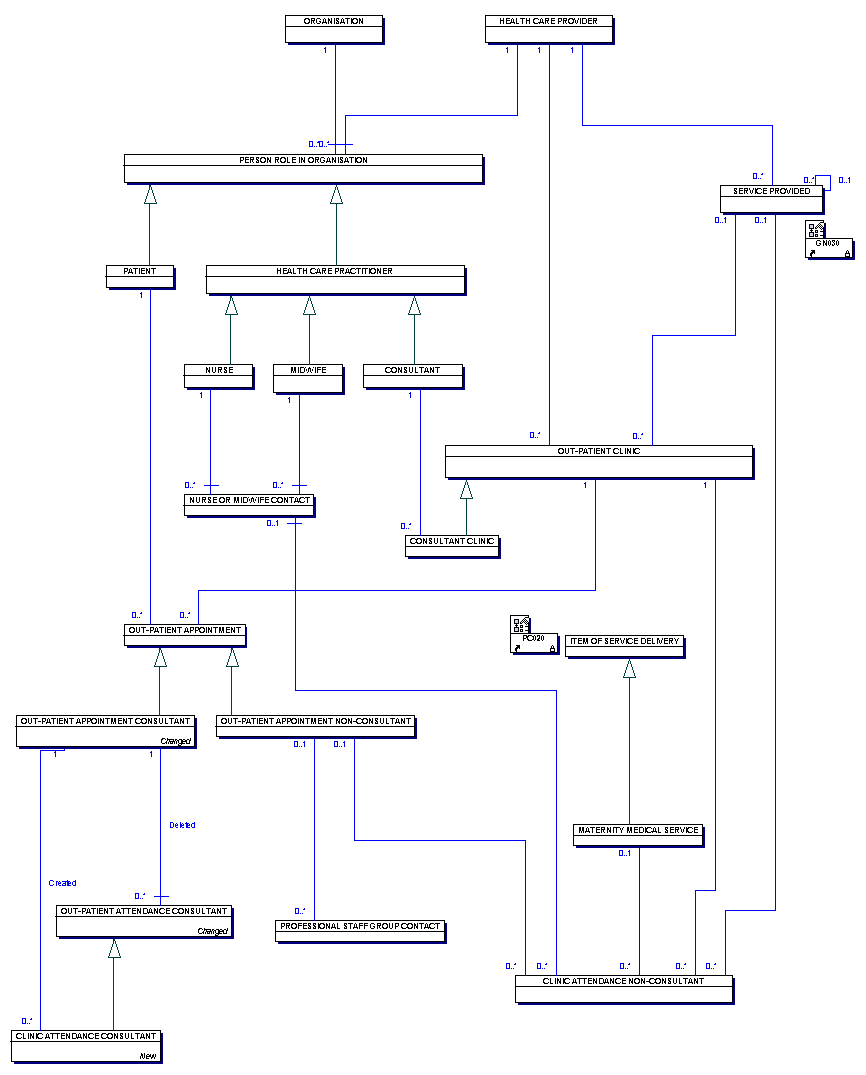
HP040 Out-Patient Attendances 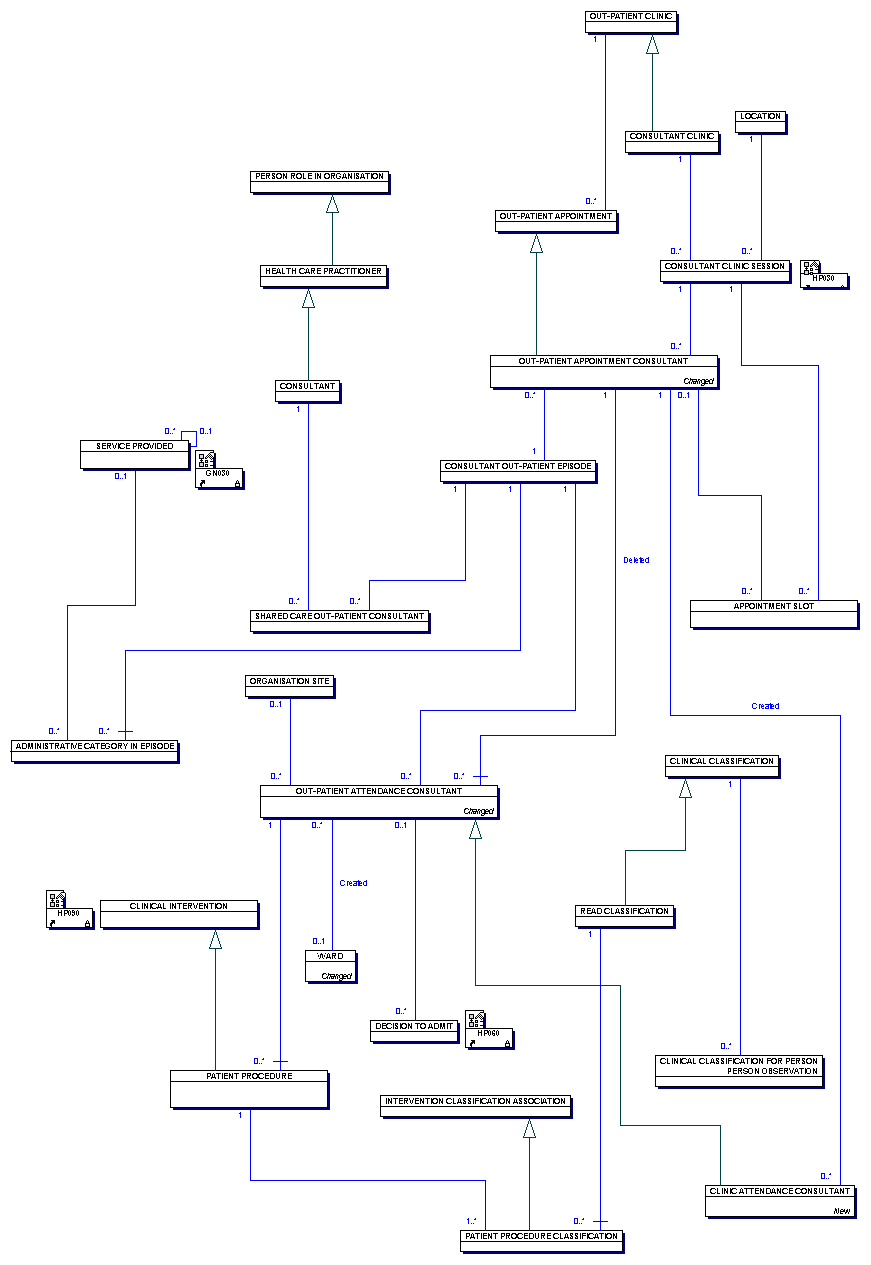
KC65 Colposcopy Clinics: Referrals, Treatments and Outcomes 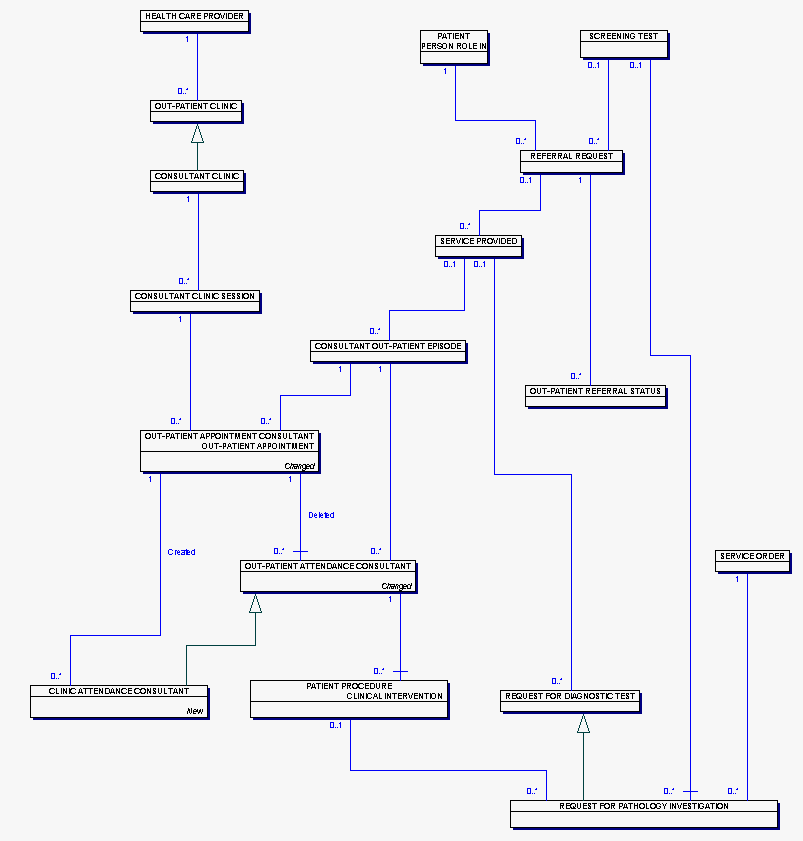
KH09 Consultant Out-Patient Attendance Activity & Accident and Emergency Services Activity 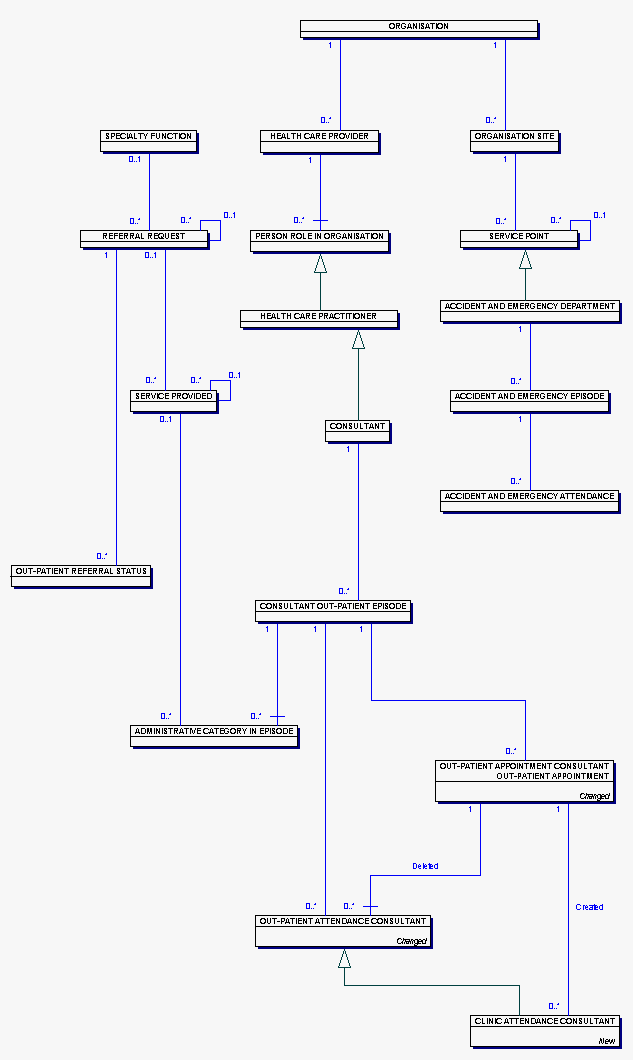
QM08 Out-Patient First Attendances - Provider 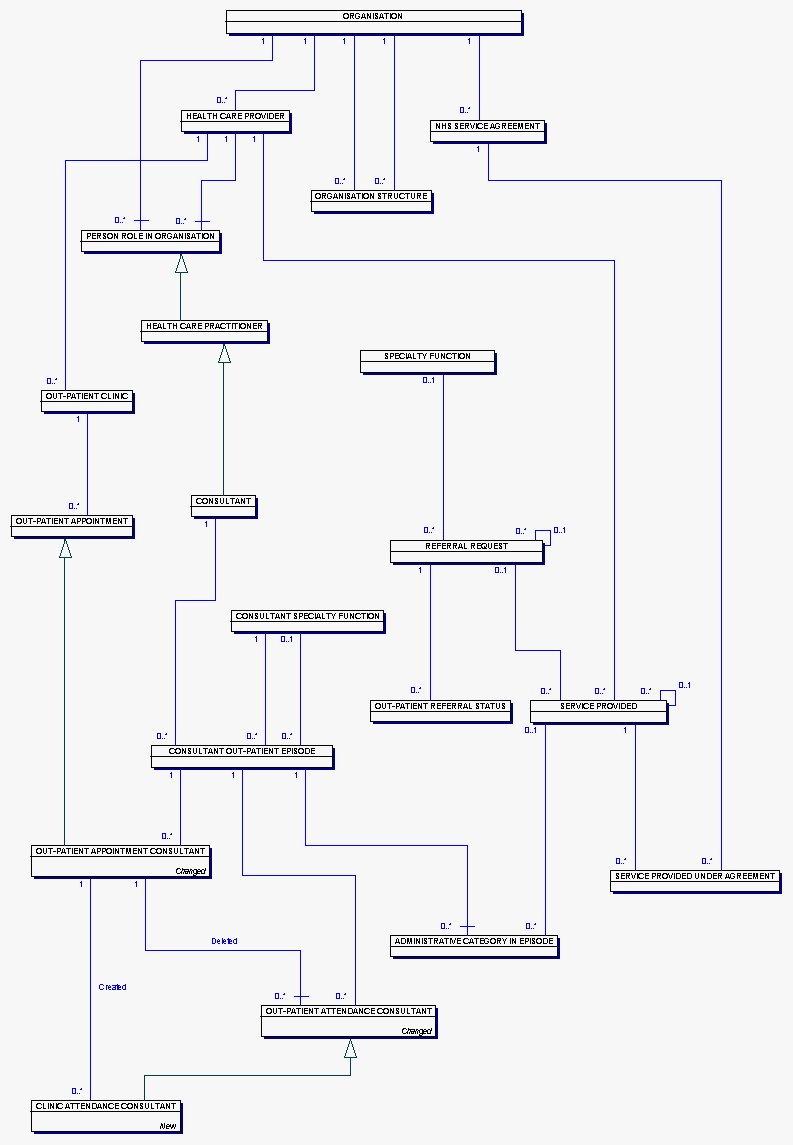
QM08R Out-Patient First Attendances: Responsible Population Based 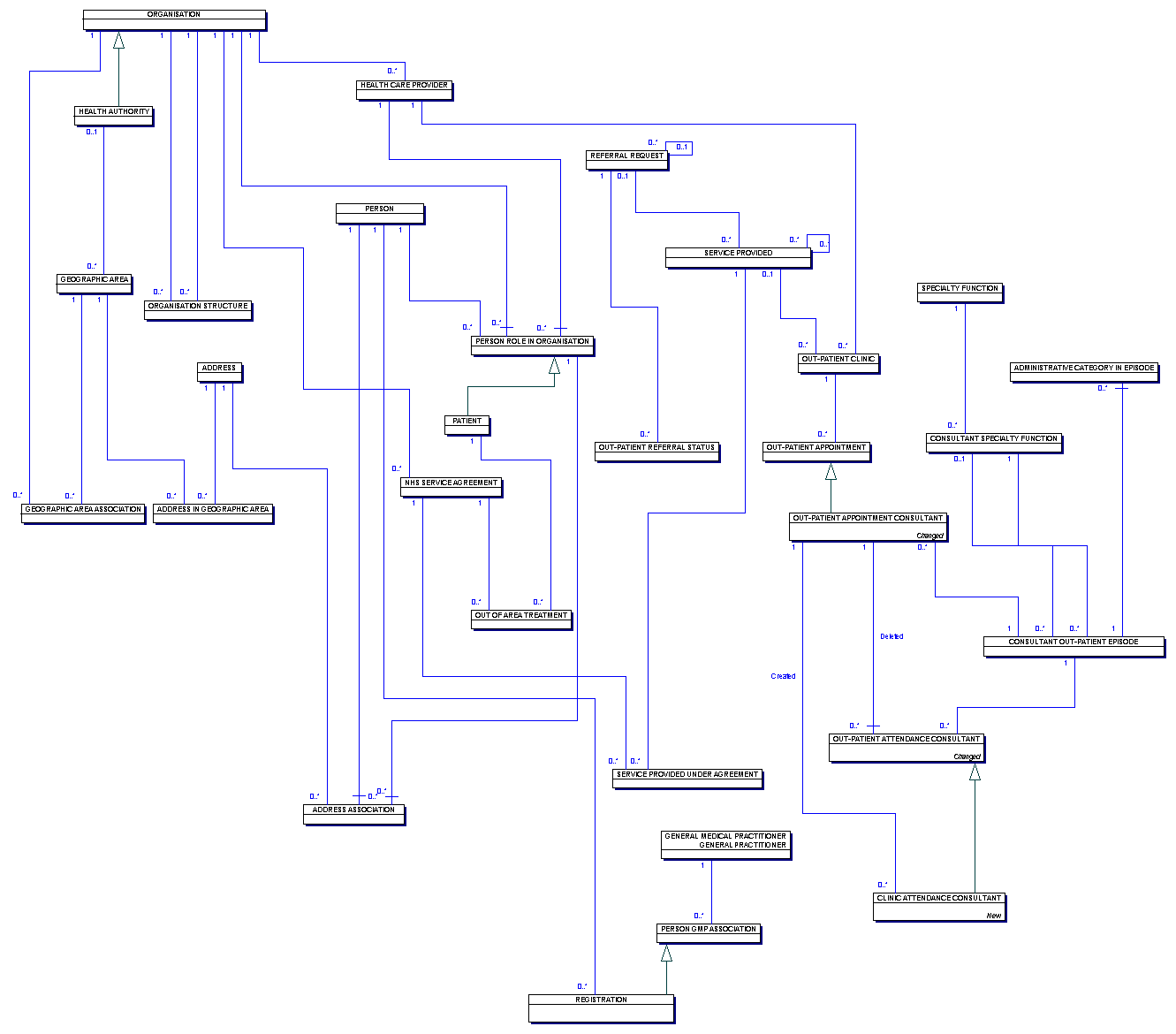
| Model View Diagram - Overview |
This diagram shows entity types relevant to PATIENTS who are due to attend OUT-PATIENT CLINICS.
A PATIENTis booked into an OUT-PATIENT CLINICby having an OUT-PATIENT APPOINTMENT.
A
An OUT-PATIENT APPOINTMENTmay result in a CLINIC ATTENDANCE NON-CONSULTANT or an OUT-PATIENT ATTENDANCE CONSULTANT (see HP040).
An
A
An OUT-PATIENT APPOINTMENT CONSULTANT may result in OUT-PATIENT ATTENDANCES CONSULTANT.
An OUT-PATIENT APPOINTMENT may result in CLINIC ATTENDANCE CONSULTANT.
| Model View Diagram - Overview |
This diagram shows entity types relevant to patients making OUT-PATIENT APPOINTMENTS. Attendances may be at a CONSULTANT CLINIC, a type of OUT-PATIENT CLINIC.
A CONSULTANT OUT-PATIENT EPISODE will comprise one or more OUT-PATIENT ATTENDANCES CONSULTANT.
CLINIC ATTENDANCES CONSULTANT will always have an OUT-PATIENT APPOINTMENT CONSULTANT (even when the PATIENT arrives with no prior notice), but an
An episode could involve shared consultant care in which case the CONSULTANTS sharing responsibility for the PATIENTS with the main
For each
The attribute TIME SEEN, used to calculate the waiting time between the appointment and consultation, need only be recorded for OUT-PATIENT ATTENDANCES CONSULTANTon a sampling basis to be determined locally.
The attribute TIME SEEN, used to calculate the waiting time between the appointment and consultation, need only be recorded for CLINIC ATTENDANCE CONSULTANT on a sampling basis to be determined locally.
A PATIENT PROCEDURE performed during an OUT-PATIENT ATTENDANCES CONSULTANTmust have at least one PATIENT PROCEDURE CLASSIFICATION classified by a READ CLASSIFICATION.
A PATIENT PROCEDURE performed during an
Please address enquiries about this DSCN to:-
Data Standards Team
NHS Information Authority
Aqueous II
Aston Cross
Rocky Lane
Birmingham
B6 5RQ
Tel: 0121 333 0333